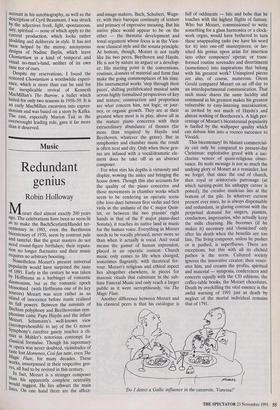Music
Redundant genius
Robin Holloway
Mozart died almost exactly 200 years ago. The celebrations have been so neon-lit as to make the Bach/Scarlatti/Handel ter- centenary in 1985, even the Beethoven bicentenary of •1970, seem by contrast pale and tasteful. But the great masters do not need round-figure birthdays; their reputa- tion no longer fluctuates and their music requires no arbitrary boosting. Nonetheless Mozart's present universal Popularity would have surprised the taste of 1891. Early in the century he was taken by Hoffmann as a harbinger of romantic daetrionistn, but as the romantic epoch blossomed (with Hoffmann one of its key sources) Mozart was seen rather as an island of innocence before music realised its full powers. Between the summits of Bach ian polyphony and Beethovenian sym- Phonism came Papa Haydn and the infant Mozart. Schumann's well-known view (incomprehensible to us) of the 0 minor Symphony's carefree gaiety reaches a cli- niax in Mahler's notorious contempt for classical formulae. Though his supremacy in opera was never doubted, vicissitudes of taste lost Idorneneo, Cosi fan tittle, even The Magic Flute, for many decades. These works, unsurpassed in their respective gen- res, all had to be revived in this century. In fact, Mozart is a stranger composer than his apparently complete centrality would suggest. He lies athwart the main lines- On one hand there are the affect-
and-image-makers, Bach, Schubert, Wagn- er, with their baroque continuity of texture and primacy of expressive meaning. But his native place would appear to be on the other — the thematic development and tonal argument whose focus is in the Vien- nese classical style and the sonata principle. At bottom, though, Mozart is not really like his two peers, Beethoven and Haydn. He is not by nature an arguer or a develop- er. His starting point is the conventions, routines, donnees of material and form that make the going commonplaces of his time. His instrumental works 'step through their paces', shifting prefabricated musical units across highly formalised perspectives of key and texture; construction and proportion are what concern him, not logic, or jour- ney, or organic growth. They are at their greatest when most is in play, above all in the mature piano concertos with their extraordinary abundance of themes (far more than required by Haydn and Beethoven, whatever the genre). But in symphonies and chamber music the result is often neat and dry. Only when these gen- res are infused with a vocal/dramatic ele- ment does he take off as an abstract composer.
For what stirs his depths is virtuosity and display, wowing the aisles and bringing the house down. Though this also accounts for the quality of the piano concertos and those movements in chamber works which seem to be rendering an operatic scene (the love-duet between first violin and first viola in the andante of the C major Quin- tet, or between the two pianists' right hands in that of the F major piano-duet Sonata), it reaches its native land in music for the human voice. Everything in Mozart needs to be vocally phrased, never more so than when it actually is vocal. And vocal means the gamut of human expression, placed in an operatic context. Church music only comes to life when charged, sometimes flagrantly, with theatrical fer- vour. Mozart's religious and ethical aspect lies altogether elsewhere, in pieces for masonic rituals that culminate in the sub- lime Funeral Music and only reach a larger public as it were surreptitiously, via The Magic Flute.
Another difference between Mozart and his classical peers is that his catalogue is
full of oddments — bits and bobs that he touches with the highest flights of fantasy. Who but Mozart, commissioned to write something for a glass harmonica or a clock- work organ, would have bothered to turn these unappealing tasks (we have his word for it) into one-off masterpieces; or lav- ished his genius upon arias for insertion into other composers' operas; or trans- formed routine serenades and divertimenti (sometimes) into inspirations that belong with his greatest work? Uninspired pieces are also, of course, numerous. Glenn Gould compared Mozart on an off-day to an interdepartmental communication. That such music shares the same lucidity and command as his greatest makes his greatest vulnerable to easy-listening muzakisation, as invited by not much of Haydn's , and almost nothing of Beethoven's. A high per- centage of Mozart's bicentennial popularity is fuelled by the wallpaper quality which can debase him into a rococo successor to Vivaldi.
This bicentenary! Its blatant commercial- ity can only be compared to present-day Christmas: exploitative greed with a sac- charine veneer of quasi-religious obser- vance. Its main message is not so much the undying glory of Mozart as a reminder, lest we forget, that since the end of church, then royal or aristocratic patronage (at which turning-point his unhappy career is poised), the creative musician lies at the bottom of the pile. In whatever current present ever since, he is always dispensable and redundant, in glaring contrast with the perpetual demand for singers, pianists, conductors, impresarios, who actually keep the mills churning. He becomes (if he makes it) necessary and 'classicised' only after his death when the benefits are too late. The living composer, unless he pushes or is pushed, is superfluous. There are exceptions, but this with all its cliched pathos is the norm. Cultured society ignores the innovative creator; then vener- ates him, and creams the profits, spiritual and material — symposia, conferences and concerts equally with the CD editions, the coffee-table books, the Mozart chocolates. Death by overkilling the vital essence is the awful warning of 1991 just as death by neglect of the mortal individual remains that of 1791.
`Do I detect a Gallic influence in the casserole, Vanessa?'








































































 Previous page
Previous page